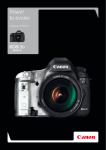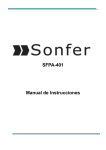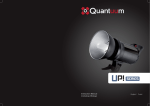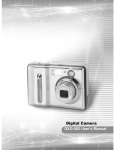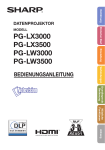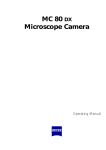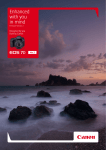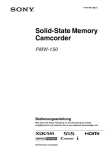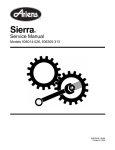Download Canon EOS-1DX Instruction manual
Transcript
Power to perform Performance redefined 2 Tv (Shutter Speed): 1/1250 Av (Aperture Value): f/5.0 ISO Speed: 4000 Lens: EF400mm f/2.8L IS II USM Focal length: 400.0mm Image quality from the EOS-1D X impresses whatever the conditions. High resolution and wide dynamic range are accompanied by accurate skin-tone reproduction and colour depth. And when light levels get low, the EOS-1D X keeps performing with high-ISO capabilities that have to be seen to be believed. Continuous shooting at rates up to 14 fps* are complimented by a sophisticated 61-point autofocus system that tracks objects, recognises faces with more accuracy than ever before. The EOS-1D X is as at home on location as it is in the studio. Designed for fashion, portrait, sports and reportage photographers alike – this may be the only camera you will ever need. Brochure Photography: Bruno Barbey, Julian Love, Iain Weir, Ziv Coren: © Ziv Koren/Polaris Images. Canon Ambassador, Brutus Östling: © Brutus Östling. Canon Ambassador, on the Canon EOS-1D X 3 A high-resolution sensor captures the amazing detail, while broad dynamic range ensures texture is preserved in both dark shadows and bright highlights. A bespoke 18.1-megapixel CMOS sensor delivers superb image quality in picture files measuring 5208 x 3477 pixels – enough for a 51MB TIFF file. Colours are reproduced accurately and smooth tonal gradation ensures that even the most subtle details are recorded faithfully. 4 The EOS-1D X makes use of gapless micro lenses that individually cover each pixel on the sensor’s surface, boosting sensitivity. Wide dynamic range means more detail in dark shadows and fewer blown highlights. 14-bit processing ensures the maximum amount of image data is written into an EOS-1D X RAW file, or used to produce high quality 8-bit JPEG files for instant use straight out of the camera. Redefining image quality Full-frame photography The 24x36mm sensor inside the EOS-1D X is exactly the same size as 35mm film, meaning wide-angle lenses can be used to their true potential, producing a wide field of view and enabling photographers to exploit shallow depth of field from fast-aperture lenses, for visual emphasis. A/D converter front-end processing circuit A/D converter front-end processing circuit A/D converter front-end processing circuit A/D converter front-end processing circuit A larger sensor allows the size of the individual photosites to be increased, enabling more light to be gathered. This results in less noise, especially at high ISO sensitivities, and greater dynamic range. DRAM DIGIC 5+ CF Card DIGIC 5+ CF Card DRAM 5 Microlenses Seeing in the dark Showing extraordinary versatility, the EOS-1D X has an ISO sensitivity range that covers ten stops, from ISO 100 to ISO 51,200. Expansion settings take this further, up to ISO 102,400 and ISO 204,800 – ideal for specialist applications in surveillance or documentary photography. The ISO range is also expandable down to ISO 50 for those bright days or when you want to slow your shutter speed down. High-ISO shooting gives you the versatility to choose the exposure settings you need regardless of the lighting conditions. For example, retain depth of field control with a wider range of apertures, or avoid motion blur with high shutter speeds. The EOS-1D X lets you maintain your creative freedom in a wider range of conditions than ever before. 6 Such advances in sensitivity are the result of improving the engineering processes used in the manufacture of the EOS-1D X’s 18-megapixel CMOS sensor. Gapless micro lenses cover each photosite, focusing light from all angles and capturing more light than ever before. The efficiency with which this light is turned into an electronic signal (the photoelectric conversion rate) is also improved over previous generations of cameras. Such enhancements to the natural sensitivity of the sensor mean that high ISO values can be achieved with less reliance on signal amplification, preserving image quality and reducing noise. Any noise generated at high ISO settings, or produced during long exposures, is tackled during image processing by the camera’s Dual “DIGIC 5+” microprocessors. Photo Diode CMOS Sensor Gapless micro lens Auto ISO control Automatic ISO control enables the EOS-1D X to use ISO sensitivity to control exposure automatically, just as with aperture and shutter speed. Minimum and maximum ISO values can be set, governing the range over which ISO sensitivity is allowed to fluctuate. The EOS-1D X is as capable in low-light conditions as it is in the midday sun. A next-generation sensor increases sensitivity while sophisticated image processing tackles digital noise. DIGIC 5+ technology At the heart of every current EOS is the DIGIC processor, which not only controls a camera’s main functions but also converts sensor data into viewable image files. The EOS-1D X uses a pair of newly developed DIGIC 5+ processors to handle the huge amount of data coming from the camera’s 18-megapixel sensor at shooting rates of up to 14fps. Additionally, the EOS-1D X contains an extra DIGIC 4 processor, which powers the EOS intelligent Subject Analysis system (iSA), plus an additional dedicated microprocessor that controls autofocus. Numerous improvements to picture quality are made during image processing. As well as noise reduction at high ISO sensitivities, the EOS-1D X looks after tonal range and colour reproduction as well as enhancing lens quality. Auto Lighting Optimizer Lens correction The Auto Lighting Optimizer function uses Canon’s EOS Scene Detection technology to optimise brightness, contrast and saturation according to detailed analysis of the subject. In particular it addresses dynamic range, preserving highlights in bright areas through careful exposure metering, while brightening shadows with subtle adjustments to contrast. The EOS-1D X performs three types of lens correction, further enhancing the quality of Canon’s EF lens range. The strength of the Auto Lighting Optimizer can be adjusted with one of four settings: off, low, standard or strong. Peripheral illumination correction aims to counteract the effect of any light fall-off towards the edges of the frame, which can be seen when shooting at wide apertures. Chromatic aberration correction tackles coloured fringing effects and soft halo artefacts that can come from lateral and axial chromatic aberration – when light of different colours focuses at slightly different points. Distortion correction can be applied during image playback when required. It addresses the small levels of pincushion and barrel distortion sometimes seen when straight-line objects are visible near the edges of the frame. 7 The figures speak for themselves: shooting up to 14 full-frame images every second at its maximum, 18.1-megapixel resolution, this is the fastest EOS camera yet. Secondary Mirror Balance Weight / Locking Mechanism Performance EOS photographers can enjoy both high image resolution and fast continuous shooting. The EOS-1D X captures full-frame 18.1-megapixel images in JPEG or RAW format at an astonishing 12 frames per second (fps), maintaining full auto-exposure and autofocus capabilities. Shooting speed can be pushed further to 14 fps in Super High Speed mode, by locking up the camera’s mirror and fixing exposure and focus.* A large buffer and powerful Dual “DIGIC 5+” processors mean 180 JPEG or 38 RAW images* can be captured in a single burst. That’s enough for 15 seconds of continuous, high-speed shooting using jpeg. 8 *With UDMA mode 7 CF card Main Mirror Locking Mechanism Main Mirror Balance Weight High performance through new engineering Such high performance is only made possible by new approaches to engineering – both electronic and mechanical. 16-channel data readout from the CMOS sensor increases the speed with which data can be transferred through the camera’s circuitry. Dual “DIGIC 5+” processors enable lightening-fast processing of image data and sustained performance. The reflex mirror inside the EOS-1D X has been redesigned for increased speed. Rather than falling back into place after each shot it is now powered in both directions. Quad Active Mirror Stopper technology reduces ‘mirror bounce’ and any internal vibrations that the mirror’s movement may cause. Silent shooting Built-in multiple exposure Sometimes speed isn’t everything, and a more subtle approach is required. For these occasions the EOS-1D X offers a silent shooting mode. Noise from the camera’s mechanism is reduced and separated into two stages: the reflex mirror only returns to its initial position, and the shutter is only re-cocked, when pressure on the shutter-release button is released, so you can choose the most appropriate time. Get creative with in-camera multiple exposure and continuous shooting. Simply tell the EOS-1D X how many frames you wish to capture (up to nine shots) and they will be superimposed and saved as a finished JPEG when shooting is complete. Save only the final multiple-exposure composite images to memory card, or choose to record all of the component images too. A pre-existing image can also be used as the first frame, and the brightness of each successive frame adjusted automatically for the perfect end result. * Maximum shooting rate restricted to 10 fps with battery charge less than 50 per cent or the camera’s internal temperature is very low and ISO sensitivity is 20,000 or higher. 9 AF Configuration Tool and AI Servo AF Parameters 1 Tracking sensitivity: Locked on (-2), -1, 0, +1, (+2) Responsive AF Configuration Tool 2 Accel./decel. tracking: 0, +1, +2 3 1 Versatile multi purpose setting 0 0 0 2 Continue to track subjects, ignoring possible obstacles -1 0 0 3 Instantly focus on subjects suddenly entering AF points +1 0 0 4 For subjects that accelerate or decelerate quickly 0 +1 0 5 For erratic subjects, moving in any direction 0 0 +1 6 For subjects that change speed and move erratically 0 +1 +1 High-performance autofocus Cross-type focusing Cross-type focusingatatf/2.8 f/2.8 Vertical-line focusing at Vertical-line at f/4 f/4 Vertical-line at f/5.6 f/5.6 Vertical-line focusing at Horizontal-line focusing f/5.6 Horizontal-line focusing at f/5.6 Zone AF Cross-type focusing at f/2.8 Vertical-line focusing at f/4 Vertical-line focusing at f/5.6 Horizontal-line focusing at f/5.6 Intuitive controls and astonishing sensitivity, even in light as low as -2EV results in a focusing system you can trust, no matter what the conditions throw at you. 61-point wide area focussing Spread out across the frame are 61 focus points, providing a large area of AF sensitivity. This includes 41 cross-type points, five of which are a double cross-type design, for enhanced sensitivity to both vertical and horizontal lines. The sensitivity and nature of each focus point depends on the lens in use. The EOS1D X automatically configures its AF system to match the lens in use, maximising the number of cross-type AF points in use at any one time. Cross-type focusing points can now be used with more lenses than ever before, including lens-extender combinations with a maximum aperture of f/5.6. 10 Focus points can be used individually, in groups or all at once, depending on your shooting style and subject matter. The EOS-1D X even recognises when you move between landscape and portrait orientations, and shifts the active focus point accordingly – great if you are working with a subject that is over one side of the frame, for instance. An Intelligent Viewfinder display shows active focus points as you are framing your composition, ensuring you stay informed and in control. AF pt auto switching: 0, +1, +2 The EOS-1D X uses a sophisticated 61-point High Density Reticular Autofocus system that is versatile enough to satisfy the demands of every type professional photographer, from those shooting sports and photojournalism to portrait and wedding photographers. Single point 4-point expansion Adjustable servo AF No two moving objects behave in the same way, which is why the EOS-1D X has an AI Servo focusing mode that can be customised according to the conditions. Independently fine tune tracking sensitivity, tracking of acceleration and AF point auto switching depending on how the subject is moving and what else might be in the frame. 8-point expansion EOS iTR subject tracking For example, when photographing a fastmoving object that changes direction unpredictably, boosting the acceleration tracking sensitivity and AF point auto switching speed will help keep the subject in focus. On the other hand, following a subject though a scene where line of sight is occasionally obstructed by other objects, such as undergrowth and tree branches, requires reduced tracking sensitivity to prevent focus from jumping away from the subject unintentionally. Enjoy complete manual control over these parameters, or choose from six preset combinations for quick and easy focusing adjustment. Intelligent Tracking and Recognition (iTR) technology combines data from the 61-point AF and 100,000-pixel exposure metering systems, enabling the EOS-1D X to track moving objects as they cross the frame, ensuring they are always in focus. A 100,000-pixel exposure sensor recognises faces and detects colour. This enables it to change focus point automatically, following the face or coloured object that it first locked on to for superb focusing accuracy. In One-Shot AF mode, face recognition enables automatic selection of AF points that are covering a face, if present. 11 Every time you compose a photograph with the EOS-1D X, the camera’s sensors analyse the scene too. A 100,000-pixel RGB Metering Sensor is divided up into 252 metering zones for high precision measurement of the scene. Colour and brightness information is mixed with data from the autofocus system. The result? Perfect ambient light or flash exposures every time. Exposure control For more control in specific lighting conditions, centreweighted, partial and spot metering options are available. The position of the spot meter can be linked to the active focus point, and multi-spot readings are also available. The EOS-1D X’s 100,000-pixel RGB Metering Sensor, powered by a dedicated DIGIC 4 processor, analyses each scene, looking for colour and the presence of faces. If a prominent colour is found, exposure readings are altered to prevent over or under exposure. When a face is detected in the frame, exposure metering is biased towards this area, minimising errors and improving the reproduction of skin tones. Subject recognition data is also used to improve the accuracy of auto white balance (AWB) and Auto Lighting Optimizer (ALO) technology. 12 PS Auto Subject recognition EOS Scene Detection System AF AWB Face Contrast Movement Distance Brightness Colour tone Colour saturation ALO AE PS AWB ALO AF AE : Picture Style : Auto White Balance : Auto Lighting Optimizer : Auto Focus : Auto Exposure Shooting and exposure modes Custom exposure modes The EOS-1D X features electronically timed shutter speeds from 1/8000 – 30sec, with flash synchronisation up to 1/250sec. Program, aperture priority (Av), shutter priority (Tv) and manual exposure modes are available, alongside a bulb (B) setting for long exposures. Three custom exposure modes are available for instant recall of frequently used camera settings Three custom shooting modes are available in which photographers can register favourite combinations of camera settings for instant recall. These appear alongside other exposure modes as C1, C2 and C3 and are accessed with the MODE button. It is also possible to switch between custom modes with the EOS-1D X at your eye, using the multi function button next to the shutter release – a great way of adapting your shooting settings to suit the conditions as they change around you. Exposure compensation of +/- 5 EV is available, alongside auto exposure bracketing (AEB) of up +/-9 EV across seven images – perfect for those times where correct exposure is critical, or for HDR applications requiring multiple frames of differing brightness. 13 Shoot Full HD video on the same camera you use for your still photography, using Canon EF lenses and manual control to make your footage stand out from the crowd. Professional high-definition video capture Capture high-quality video at 1080p resolution and enjoy complete creative control when shooting. The EOS-1D X features new levels of functionality following feedback from professional cinematographers. Image quality is improved with new anti-moiré processing and industry-standard compression algorithms. Complying to industry standards Video is saved with the widely used H.264 codec, but users may now choose the most suitable method of compression for their needs. IPB compression references previous and next frames, resulting in small files sizes – great for longer clips or when storage space is tight. Access the QR code with your mobile device to view the EOS-1D X sample video 14 When premium quality is required, choose ALL-I compression, which treats every frame individually. Although the final file size is larger, footage is easier to edit without loss of image quality, making it more suitable for broadcast applications and cinematography. The EOS-1D X also now records SMPTE (Society of Motion Picture and Television Engineers) time-code information in the standard HH:MM:SS:FF format. The EOS-1D X allows continuous recording of up to 29mintues 59 seconds using an auto file creation system. A new movie file is created automatically once the limit of 4GB for a single file is reached. You don’t have to stop recording and the files can joined together seamlessly during editing. Flexible creative control Crystal clear digital audio The same Canon EF lenses you use for still photography also provide opportunities for highly creative video shooting. Work with large apertures for shallow-focus effects, or use speciality optics, such as macro or perspective-control lenses, for special optical effects. Capture digital sound at 48KHz using the camera’s built-in microphone, or with an external unit via a standard 3.5mm mic jack. Recording level can be set manually to one of 64 levels, and even adjusted during shooting with a touch-sensitive Movie Silent Control. Take advantage of the EOS-1D X’s lowlight sensitivity, shooting at ISO settings between ISO 100 and ISO 25,600. A full range of exposure modes is available, offering manual control when you need it, and automation when you’re working under pressure. Manual control; improved handling The EOS-1D X offers manual control over exposure, picture style, focusing, frame-rate and audio. Many of these settings are accessible though the camera’s quick control screen, even while video capture is taking place. A touch-sensitive control pad on the inner edge of the Quick Control Dial offers silent, vibration-free operation. A dedicated Live View button on the back of the camera gives instant access to movie shooting. A Movies tab in the camera’s menu system draws together video settings in one convenient place. 15 The EOS-1D X is designed to feel like a part of you – like an extension of your eye. It is a creative tool that has evolved over 10 generations of Canon professional cameras. The product of a continuous design process that incorporates feedback from professional photographers just like you. What does ergonomic mean to you? Easy-to-use controls The position, shape and feel of every control on the EOS-1D X has been revisited to ensure quick and easy operation. The cameras controls are intuitive, allowing quick adjustments even when it’s at your eye. Buttons have been designed to be large enough to be used even when wearing gloves. The famous EOS-1 series integrated vertical shooting grip now offers a greater level of duplicate controls when shooting portrait-orientation images, right down to the depth-of-field preview and custom function buttons. 16 Clear View LCD II Clear View LCD Anti-reflection coating Protective glass cover Optical elastic material layer Liquid crystal panel Anti-reflection coating Protective glass cover Liquid crystal panel Menu system Viewfinder Clear View II LCD screen The rear of the camera is home to a 8.11cm (3.2”) 1,040,000-dot Clear View II LCD screen for browsing menu systems and reviewing the camera’s status at a glance. A large, bright viewfinder make composing images with the EOS-1D X a pleasure. Approximately 100 per cent coverage ensures framing accuracy, while a transparent LCD panel overlays AF information, keeping you informed of where the camera is focusing. The camera’s Clear View II LCD screen displays sharp, bright, colourful images and is made from toughened glass. The space between the glass and the screen is filled with an electrostatic gel that minimises reflections, even in bright sunlight. The menu system is easy to navigated using the multi-way controller and now contains dedicated tabs for AF and Movie Mode functions, as well as a customisable My Menu section. A Quick Control screen, showing a summary of the camera’s status, is displayed with a single press of the Q button on the rear of the camera and offers quick access to many of the camera’s functions. Pressing the info button displays a feature guide: help screens that explain each of the menu options in a clear, concise fashion. The amount and type of information provided in the camera’s viewfinder can be customised to suit personal preferences. Display grid lines to help with architectural or copy work, and choose how focus points are shown: all of the time or disappearing once focus lock has been established. Customisation We are all different, which is why the EOS-1D X can be set up just the way you like it. Dozens of custom functions allow fine-tuning of the camera’s behaviour, and most controls – including two multi-function buttons – can be assigned to perform different tasks while shooting. Autofocus and exposure metering can be configured exactly to your preferences – whether you are shooting sports on location or fashion in the studio. And when you’ve found the perfect set-up, configurations can be saved to memory card for instant recall or even transfer to another EOS-1D X body. 17 Locations provided with dustproof and drip-proof measure Designed to perform. Built to last. Dual card slots, which support the latest UDMA 7 high-speed memory card standard, provide space for a second CF memory card, enabling RAW and JPEG files to be stored on separate media. EOS integrated cleaning system Versatile power source Conventional sensor-cleaning technology shakes off dust and dirt by vibrating the protective filter that sits in front of the camera’s sensor. The EOS-1D X takes this concept further by using carrier waves to roll debris away from the sensor’s surface – an approach that removes even the smallest of particles. The EOS-1D X is powered by a single LP-E4N battery, but also retains compatibility with existing LP-E4 batteries from EOS-1Ds Mark III, EOS-1D Mark III and EOS-1D Mark IV cameras. Up to 1120 shots can be made on a single charge. The camera’s low-pass filter is also coated with an anti-static fluorine coating to help keep pictures free from dirt and dust spots. This combination of anti dust technology minimises the time required to retouch images and clean your camera, so you can spend more time shooting pictures and give your clients a faster turnaround. 18 From war zone to touchline, the EOS-1D X delivers reliable performance time after time.Comprehensive weather sealing protects against dust and moisture, while a magnesium-alloy chassis provides strength without adding weight. The camera’s focal plane shutter is tested to 400,000 activations. Dual card slots provide space for a second CF memory card, enabling RAW and JPEG files to be stored on separate media. 19 Connectivity and camera control Extend the functionality of the EOS-1D X and discover new creative avenues, with multiple options for tethered shooting and remote camera control. As well as storing images on Compact Flash memory cards, the EOS-1D X can write files directly to a PC or Mac using a tethered connection, or wirelessly with an optional WFT-E6 WiFi transmitter. Such tetheredshooting techniques allow images to be inspected on a large colour-calibrated computer screen as they are being shot, so you (and your clients) can see exactly what is happening at every stage of the shoot. Photographers working to tight deadlines will benefit from built-in Gigabit Ethernet connectivity. When shooting in LAN-equipped locations, such as sports stadiums, images can be transmitted from camera directly to a picture editor for captioning, editing and that all-important first publication. 20 EOS Utility for direct camera control The EOS-1D X can be set up for tethered shooting using USB 2.0 or Gigabit Ethernet connections, or configured for wireless operation with the WFT-E6 WiFi adaptor. The supplied EOS Utility software not only shows pictures on your PC or Mac’s screen as they are captured, but also allows control of the camera’s major functions, including remote triggering. It’s even possible to compose images on your computer’s screen using remote live view. Positioning and firing your EOS remotely opens up new creative opportunities and new viewpoints that are inaccessible when shooting normally. WiFi and GPS adaptors Wireless control over a Canon EOS-1D X is possible using the WFT-E6 wireless adapter. Enjoy wireless shooting directly to a PC or Mac on a wireless network, or operate the camera remotely using EOS Utility or the WFT server function. Geotagging of images – where location and altitude data is embedded into the metadata of each image file – is possible using a GPS receiver. The camera-powered GP-E1 connects via the EOS-1D X’s System Extension socket, while the hotshoemounted GP-E2 is independently powered and supports data-logging capabilities. FTP Transfer Transfer images to an FTP server Gigabit Ethernet for wired LAN access EOS Utility Use EOS Utility to capture, view, and download images remotely WFT Server Use a web browser to capture, view, and download images remotely Media Server View images on a DLNA-compatible TV or other devices Adding Ethernet connectivity provides tethered shooting and camera control over much greater distances than USB 2.0, and at much higher speeds. Local area network (LAN) settings are easy to configure via the EOS-1D X’s menu system. The EOS-1D X can transfer images in a number of different ways. Automatic Transfer sends picture files to the computer immediately after they are shot whereas, in Image Selection mode, only images tagged during playback are transmitted. It’s also possible to append comments and caption information to the file with EOS utility. The EOS-1D X features WFT server technology, enabling remote camera operation and live view using an internet browsing software on smart phones or tablets. Time synchronization between cameras Synchronize the clock settings of slave cameras with the clock of the master camera 21 Flash photography From the moment a Speedlite flashgun is mounted on the Canon EOS-1D X the camera’s E-TTL flash metering technology begins to take the hard work out of flash photography. Information regarding the size of the camera’s sensor and the lens in use is communicated to the Speedlite and the correct zoom position is set. E-TTL II metering also communicates white balance, colour information, exposure mode and aperture, shutter speed and ISO settings to the Speedlite. Speedlite 600EX-RT Speedlite Transmitter ST-E3-RT When the shutter release is half pressed an ambient light reading is make and focus is locked. Depress it fully and a pre-flash is emitted by the Speedlite, with the light reflected being compared to the ambientlight exposure. Distance data from the AF system is also incorporated into the equation along with colour and face-detection information is used to identify which parts of the scene are most important. 22 Flash-exposure lock enables photographers to lock focus and change composition without fear of exposure error, and E-TTL II works just as effectively for off-camera flash as it does for a Speedlite connected to the EOS-1D X’s hotshoe. Further creative effects are accessible with special flash modes, like Multi flash shooting and second-curtain sync. High-speed flash synchronisation enables flash shooting at any shutter speed up to 1/8000sec, ideal for fill-in flash in bright conditions. Speedlite 600EX-RT and Speedlite Transmitter ST-E3-RT may not be available in all regions. Off-camera wireless flash Free your flashgun from the camera and discover a whole new world of creative lighting options. The EOS-1D X can fire multiple Speedlites placed up to 30m away from the camera, with no direct line of sight required when using radio transmission. Simply place a trigger, such as the ST-E3-RT, in the camera’s hotshoe and the sophisticated E-TTL II metering takes care of flash-exposure issues automatically. The Speedlite 600EX-RT flash can also act as a radio trigger, controlling other guns placed off camera. Simultaneous wireless control of up to five groups of Speedlite flashes is possible. A photographer can control the relative power of these groups by adjusting an individual flash’s output or the power ratio between groups. 23 The EOS digital workflow ImageBrowser EX Digital Photo Professional Canon is the only photographic manufacturer that can provide a solution for every step of a photographer’s workflow – from capture through processing to print. EOS solutions Advanced RAW file processing Supplied with the EOS-1D X is an EOS Solutions disk, containing applications that further enhance the performance and functionality of the camera. Digital Photo Professional (DPP) is an image-editing application designed for the viewing and processing of JPEG and RAW images. White balance, colour saturation and exposure compensation of RAW files can all be set after capture, as part of a non-destructive workflow. Any traces of vignetting, distortion and colour fringing are also easily corrected. High dynamic range (HDR) images can be generated in DPP from RAW or JPEG files shot at different exposures. A number of tonemapping presets are supplied, enabling you to create the right look for your subject matter. Single frames can also be combined to form multiple-exposure composites. And lens correction can be controlled and applied to images as you choose. Images can be cropped and rotated before they are saved to one of many file formats, either for output, archive or further editing in an application like Adobe Photoshop. Batch processing is available for extra speed and efficiency. DPP supports sRGB, Adobe RGB and Wide Gamut RGB colour spaces, and CMYK printer simulation allows photographers to preview how their images will appear as a hard copy. EOS Utility provides tethered shooting support and remote camera control over USB, Ethernet and WiFi. Picture Style editor enables photographers to create custom Picture Style presets and upload these to the camera. Image Browser EX provides a tool for browsing of JPEG and RAW files on disk. 24 16-bit workflow Photographers shooting RAW files can preserve the full colour depth offered by this format all the way through their digital workflow. After editing in DPP or applications like Adobe Photoshop, files can be sent to Canon imagePROGRAF printers without reducing to 8-bit colour or converting to JPEG. Picture Style Editor Printing and output Take advantage of superb-quality printing up to A3+ size from a convenient desktop printer. Canon’s PIXMA range of desktop printers offers accurate colours and archival gallery-quality reproduction – perfect for everything from client proofs to portfolio and fine-art prints. The PIXMA Pro 1 offers long-life 12-ink printing, including five monochrome inks for superb black & white photography. A Chroma Optimizer improves black density and gives prints a uniform texture. Pigmentink technology offers the perfect balance between performance and longevity, making the PIXMA Pro-1 idea for fine-art print sales. For bigger prints there are Canon imagePROGRAF large-format printers, delivering stunning images up to 60 inches wide. Exhibition-standard prints are delivered quickly and consistently; an A1 glossy print is finished in under four minutes. Borderless printing allows you to print to edges of the paper, and using printing on non-Canon media is easy too thanks to the bundled media configuration tool. 25 Multi-function button Microphone Multi-function Main Dial button Microphone Strap mount Main Dial Shutter button System extension terminal Strap mount Shutter button Multi-function button 2 Ethernet RJ-45 terminal System extension terminal ExternalRJ-45 microphone IN terminal Ethernet terminal Multi-function button 2 Depth-of-field preview button HDMI mini OUT terminal External microphone IN terminal Depth-of-field preview button Self-timer lamp HDMI mini OUT terminal Remote control terminal (N3 type) Remote control terminal Audio/video OUT/Digital terminal (N3 type) Self-timer Grip lamp Grip Vertical-grip Multi-function button 2 Vertical-grip Multi-function button 2 Depth-of-field Vertical-grip preview button Vertical-grip Depth-of-field preview button Audio/video PC terminal OUT/Digital terminal PC terminal Flash-sync contacts Hot shoe Flash-sync contacts Shooting mode selection button AF mode selection/Drive mode Shooting mode selection button selection button AF mode selection/Drive mode selection button AEB setting button Eyepiece shutter lever Hot shoe LCDshutter panel illumination button Eyepiece lever selection button LCDWhite panel balance illumination button Exposure compensation/Aperture button White balance selection button AEB setting button Metering mode selection/ Flash exposure compensation button Metering mode selection/ Flash exposure compensation button Info button ISO speed setting button Exposure compensation/Aperture button ISOTop speed LCDsetting panel button Info button Menu button mount Top Strap LCD panel Menu button Dioptric adjustment knob (Hidden) Dioptric adjustment knob Viewfinder eyepiece (Hidden) LCD monitor Viewfinder eyepiece Protect/VoiceLCD memo button monitor AF point selection button Strap mount AEpoint lock button AF selection button AF AE start lock button Live Viewbutton shooting/ AF start Movie shooting button Live View shooting/ Movie shooting button Multi-controller Erase button Protect/Voice memo button Network lamp Erase button Playback button Network lamp Multi-controller Card slot cover Quick button Card Control slot cover Quick Control button Vertical-grip on/off switch Magnify/Reduce button Playback button Card/ImageMagnify/Reduce size selection button button Rear LCD panel Card/Image size selection button Voice memo Rear LCD microphone panel Vertical-grip Access lamp on/off switch Setting button Voice memo microphone Quick Control Dial Setting button Power/ Multi-function lock switch Quick Control Dial Card slot cover release handle Power/ Multi-function lock switch Card slot cover release handleSpeaker Speaker Access lamp Vertical-grip AF start button Vertical-gripAE AFlock startbutton button Vertical-grip Vertical-grip lockselection button button Vertical-grip AFAE point Vertical-grip Vertical-gripMulti-controller AF point selection button Touch pad Vertical-grip Multi-controller Touch pad Function names different from the EOS-1D IV appear in grey. 26 Vertical-grip shutter button Vertical-grip shutter button EF Lens mount index EF Lens mount index Access lamp Voice memo microphone Setting button Vertical-grip AF start button Quick Control Dial Power/ Multi-function lock switch Card slot cover release handle Speaker Vertical-grip AE lock button Vertical-grip AF point selection button Vertical-grip Multi-controller Touch pad EF Lens mount index Vertical-grip shutter button Lens release button Vertical-grip Main Dial Vertical-grip Multi-function button Battery release handle Hand strap mount Battery Tripod socket System chart ST-E2 ST-E3-RT 270EX II 320EX 430EX II 600EX-RT/ 600EX Macro Ring Lite MR-14EX Macro Twin Lite MT-24EX GPS Receiver GP-E2 Timer Remote Controller TC-80N3 Remote Switch RS-80N3 Wireless Controller LC-5 EF lenses Bundled Accessories Dioptric Adjustment Lenses Eg External microphone HDMI Cable HTC-100 (2.9 m/9.5 ft.) Anti-Fog Eyepiece Eg Eyecup Eg Stereo AV Cable AVC-DC400ST (1.3 m/4.3 ft.) Wide Strap L7 TV/Video Wireless File Transmitter WFT-E6 Cable protector Interface Cable IFC-200U (1.9 m/6.2 ft.) CR2025 lithium battery Interface Cable IFC-500U (4.7 m/15.4 ft.) Angle Finder C Hand Strap E2 EOS DIGITAL Solution Disk Software Instruction Manual LAN cable (commercially available) Wireless LAN access point Wireless LAN adapter Ethernet port Computer Focusing Screen Ec series USB port Battery Pack LP-E4N CF card Card reader AC Adapter Kit ACK-E4 Windows 7 Windows Vista Windows XP Mac OS X PictBridge-compatible printer Battery Charger LC-E4N * Battery Pack LP-E4 and Battery Charger LC-E4 are also compatible. Car Battery Cable CB-570 GPS Receiver GP-E1 * The length of all cables is approx. **m/**ft. 27 Specifications: EOS-1D X IMAGE SENSOR Type Effective Pixels Total Pixels Aspect Ratio Low-Pass Filter Sensor Cleaning Colour Filter Type Type Coverage Viewing Angle (horizontally/vertically) Coating Brightness Adjustment Display Options IMAGE PROCESSOR Type Dual “DIGIC 5+” EF (excludes EF-S lenses) Equivalent to 1.0x the focal length of the lens Modes Red-Eye Reduction X-sync Flash Exposure Compensation Flash Exposure Bracketing Flash Exposure Lock Second Curtain Synchronisation HotShoe / PC terminal External Flash Compatibility External Flash Control FOCUSING Type AF System/ Points AF working range AF Modes AF Point Selection Selected AF point display AF Lock AF Assist Beam Manual Focus AF Microadjustment TTL-CT-SIR with a dedicated CMOS sensor 61 Point / 41 f/4 cross-type AF points inc 5 dual cross type at f/2.8. The number of crosstype AF points will differ depending on the lens. EV -2 - 18 (at 23°C & ISO100) One Shot, AI Servo Automatic selection: 61 point AF. Manual selection: Single point AF (61, 41 cross type only, 15 or 9 points selectable). Manual selection: Spot AF. Manual selection: AF point Expansion 4 points (up, down, left, right). Manual selection: AF point Expansion surrounding 8 points. Manual selection: Zone AF. AF points can be selected separately for vertical and horizontal shooting Superimposed in viewfinder Locked when shutter button is pressed half way in One Shot AF mode or AF-ON button is pressed. Emitted by optional dedicated Speedlite Selected on lens, default in Live View Mode AF Menu, +/- 20 steps ( wide and tele setting for Zooms), Adjust all lenses by same amount Adjust up to 40 lenses individually. Adjustments remembered for lens by serial number Metering Range AE Lock Exposure Compensation AEB ISO Sensitivity* TTL full aperture metering with 252 zone from 100,000-pixel RGB AE sensor (1) Evaluative metering (linked to all AF point) (2) Partial metering (approx. 6.5% of viewfinder at centre) (3) Spot metering: Center spot metering (approx. 2.5% viewfinder) AF point-linked spot metering Multi/Spot metering (Max 8 spot metering entries) (4) Center weighted average metering EV 0 - 20 (at 23°C with 50mm f/1.4 lens ISO100) Auto: In One-shot AF mode with evaluative metering exposure is locked when focus is achieved. Manual: By AE lock button in P, TV and AV modes. +/-5 EV in 1/3 or 1/2 stop increments (can be combined with AEB). 2, 3, 5 or 7 Shots +/-3 EV 1/3 or 1/2 stop increments Auto (100-51200), 100-51200 (in 1/3-stop or whole stop increments). ISO can be expanded to L: 50, H1 102400, H2 204800 SHUTTER Type Speed Modes Picture Styles Colour Space Image Processing Drive modes Continuous Shooting Custom White Balance WB Bracketing Type Coverage Frame Rate Focusing Metering Display Options RAW+JPEG simultaneous recording Image Size Electronically-controlled focal-plane shutter 30-1/8000 sec (1/2 or 1/3 stop increments) + Bulb (Shutter speed range available varies according to shooting mode) Movie Type Movie Size Auto white balance with the imaging sensor AWB, Daylight, Shade, Cloudy, Tungsten, White Fluorescent light, Flash, Custom, Colour Temperature Setting. White balance compensation: 1. Blue/Amber +/-9 2. Magenta/ Green +/-9. Yes, 5 setting can be registered +/-3 levels in single level increments. 3 bracketed images per shutter release. Selectable Blue/Amber bias or Magenta/ Green bias. Movie Length Sound Files Folders File Numbering Mirror Viewfinder Information Depth of field preview Eyepiece shutter Approx. 0.76x 1 Approx. 20mm (from eyepiece lens centre) -3 to +1 m-1 (dioptre) Interchangeable (12 types, optional). Standard Focusing Screen Ec-CV Quick-return half mirror (Transmission: reflection ratio of 40:60, no mirror cut-off with EF600mm f/4 or shorter) AF information: AF points, focus confirmation light, AF status indicator. Exposure information: Metering mode, shooting mode, AE lock, shutter speed, aperture, exposure compensation, ISO speed (always displayed), exposure level, exposure warning Flash information: Flash ready, FP flash, FE lock, flash exposure level. Image information: White balance correction, highlight-tone priority (D+), maximum burst (2-digit display), CF card information, JPEG/RAW indicator, battery check icon. Composition information Grid, electronic level Yes, with Depth of Field preview button Built in LCD Panel / Illumination Water / Dust resistance Sound Memo Intelligent Orientation Sensor Playback zoom Display Formats Slide Show Histogram Highlight Alert Image Erase/Protection Computer Other Yes, with compatible External Flash Yes Yes Canon Printers PictBridge Program AE, Shutter priority AE, Aperture priority AE, Manual Auto, Standard, Portrait, Landscape, Neutral, Faithful, Monochrome, User Defined (x3) sRGB and Adobe RGB Highlight Tone Priority, Auto Lighting Optimizer (4 settings), Long exposure noise reduction High ISO speed noise reduction (4 settings) Auto Correction of Lens Peripheral illumination Chromatic aberration correction, Distortion correction, Resize to M1, M2 or S RAW image processing - during image Playback only, Multiple exposure Single, Continuous L, Continuous H, 14fps Super high speed, Self timer (2s, 10s), Silent single shooting Max. Approx. 12fps. (speed maintained for up to 180 images (JPEG)1 38 images (RAW))2 (with UDMA card)3, 14fps with mirror locked up and exposure and AF locked on first frame Electronic viewfinder with image sensor Approx. 100% (horizontally and vertically) 30 fps Manual Focus (Magnify the image 5x or 10x at any point on screen). Autofocus: Quick mode, Live mode, Live Face detection mode Real-time evaluative metering with image sensor. Active metering time can be changed Grid overlay (x3), Histogram, Aspect ratios JPEG: 10 compression options (Exif 2.3 compliant) / Design rule for Camera File system (2.0), RAW: RAW, sRAW (14bit, Canon original RAW 2nd edition), Digital Print Order Format [DPOF] Version 1.1 compliant Yes, any combination of RAW + JPEG possible, separate formats to separate cards possible JPEG: (L) 5184x3456, (M1) 4608x3072, (M2) 3456x2304, (S1) 2592x1728, RAW: (RAW) 5184x3456, (M-RAW) 3888 x 2592, (S-RAW) 2592x 1728 MOV (Video: H.264 Intra frame / inter frame, Sound: Linear PCM) 1920 x 1080 (29.97, 25, 23.976 fps) intra or inter frame 1280 x 720 (59.94, 50 fps) intra or inter frame 640 x 480 (59.94, 50 fps) inter frame Max duration 29min 59sec, Max single file size 4GB WAVE (monaural) New folders can be manually created and selected (1) Consecutive numbering (2) Auto reset (3) Manual reset 31 Custom Functions with 99 settings User copyright information (can be set in camera) Yes / Yes Yes Up to 30sec per image - 48Khz or 8Khz Yes 1.5x - 10x, Pixel level magnifaction (1) Single image with information (2 levels) (2) Single image (3) 4 image index (4) 9 image index (5) Magnified view (6) Movie edit Image selection: All images, by Date, by Folder, Movies, Stills, Rating. Playback time: 1/2/3/5/10 or 20 seconds. Repeat: On/Off Brightness: Yes. RGB: Yes Yes Erase: Single image, All images in folder, Checkmarked images, unprotected images Protection: Erase protection of one image at a time Type 2x CompactFlash Type I/II (incompatabile with Microdrive) (UDMA 7 compatible) SUPPORTED OPERATING SYSTEM PC & Macintosh Windows XP (SP2/SP3) / Vista inc SP1 (excl. Starter Edition) / 7 (excl. Starter Edition) OS X v10.6-10.7 SOFTWARE Browsing & Printing Image Processing Other ImageBrowser EX Digital Photo Professional PhotoStitch, EOS Utility (inc. Remote Capture, WFT utility*), Picture Style Editor * Requires optional accessory POWER SOURCE Batteries Battery life Battery Indicator Power saving Power Supply & Battery Chargers Rechargeable Li-ion Battery LP-E4N (supplied), 1xCR2025 for date & settings Approx.1120 (at 23°C)1 Approx. 860 (at 0°C) 6 levels + percentage Power turns off after 1, 2, 4, 8, 15, 30mins or Off. AC Adapter Kit ACK-E4, Battery charger LC-E4N, Car Battery charger cable CG-570 (use with LC-E4) PHYSICAL SPECIFICATIONS Body Materials Operating Environment Dimensions (WxHxD) Weight (body only) Magnesium Alloy body covers 0 – 45 °C, 85% or less humidity 158x 163.6x 82.7mm Approx. 1340g ACCESSORIES Viewfinder Wireless File Transmitter Lenses Flash Remote Controller / Switch Other Eyecup Eg, Eg-series Dioptric Adjustment Lens with Rubber Frame Eg, Anti Fog Eyepiece Eg, Focusing Screens Ec, Angle Finder C Wireless File Transmitter WFT-E6 All EF lenses (excludes EF-S lenses) Canon Speedlites (220EX, 270EX, 270EX II, 320EX, 420EX, 430EX, 430EX II, 550EX, 580EX, 580EX II, 600EX, 600EX-RT, Macro-Ring-Lite, MR-14EX, Macro Twin Lite MT-24EX, Speedlite Transmitter ST-E2, ST-E3-RT) Remote control with N3 type contact, Wireless Controller LC-5 Hand Strap E2, GP-E1 GPS reciever, GP-E2 GPS reciever All data is based on Canon standard testing methods except where indicated. Subject to change without notice. Magnification 1 With 50mm lens at infinity, -1m-1 dpt Continuous Shooting 1Based on Canon’s testing conditions, JPEG, ISO 100, Standard Picture Style. Varies depending on the subject, memory card brand and capacity, image recording quality, ISO speed, drive mode, Picture Style, Custom functions etc. 2Maximum fps and buffer capacity may be reduced depending on the cameras settings and light level. 3 With Battery strength 50% or higher Battery Life 1Based on the CIPA Standard and using the batteries and memory card format supplied with the camera, except where indicated * Recommended Exposure Index Some images are simulated for clarity of reproduction. All company and/or product names are trademarks and/or registered trademarks or their respective manufacturers in their markets and/or countries Canon (UK) Ltd Canon Ireland Woodhatch Reigate Surrey RH2 8BF Telephone no 01737 220000 facsimile 01737 220022 canon.co.uk 3006 Lake Drive Citywest, Saggart Co.Dublin, Ireland Telephone No: 01 2052400 Facsimile No: 01 2052525 canon.ie English Edition 0155W684 © Canon Europa N.V., 2012 Canon Compact Photo Printers and PIXMA Printers supporting PictBridge Yes STORAGE canon.com canon-europe.com Hi-Speed USB Video output (PAL/ NTSC) (integrated with USB terminal), HDMI mini output (HDMI-CEC compatible), Extension system terminal (for WFT-E6/GP-E1), External microphone (Stereo mini jack), RJ-45(gigabyte ethernet) DIRECT PRINT Yes / Yes E-TTL II with EX series Speedlites, wireless multi-flash support via camera menu screen Canon Inc. Canon Europe (1) Shooting menu (x4) (2) AF Menu (x5) (3) Playback menu (x3) (4) Setup menu (x4) (5) Custom Functions menu (x7) (6) My Menu 25 Languages English, German, French, Dutch, Danish, Portuguese, Finnish, Italian, Norwegian, Swedish, Spanish, Greek, Russian, Polish, Czech, Hungarian, Romanian, Ukrainian, Turkish, Arabic, Thai, Simplified Chinese, Traditional Chinese, Korean and Japanese Update possible by the user. INTERFACE 1/250sec (EX series Speedlites only) +/- 3EV in 1/2 or 1/3 increments OTHER FEATURES Custom Functions Metadata Tag Pentaprism Approx. 100% Firmware Update E-TTL II Auto Flash, Metered Manual FILE TYPE Still Image Type VIEWFINDER Type Coverage (Vertical/ Horizontal) Magnification Eyepoint Dioptre Correction Focusing Screen Menu Languages LIVE VIEW MODE WHITE BALANCE Type Settings Anti-reflection and Solid Structure Adjustable to one of seven levels (1) Quick Control Screen (2) Camera settings (3) Dual Axis Electronic Level SHOOTING EXPOSURE CONTROL Metering modes 8.11cm (3.2”) Clear View II TFT, approx. 1040K dots Approx. 100% Approx. 170° FLASH LENS Lens Mount Focal Length Menu Categories LCD MONITOR 36 x 24 mm CMOS Approx. 18.10 megapixels Approx. 19.3 megapixels 3.2 Built-in/Fixed with fluorine coating EOS integrated cleaning system Primary Colour




























